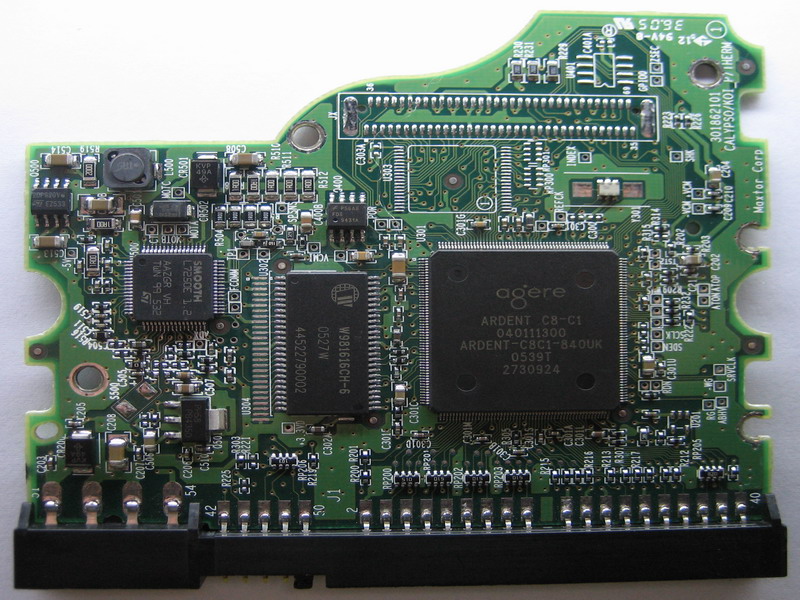An expansion card also known as an add-on card, internal card or interface adapter, is an electronic circuit board that can be inserted in a desktop computer for additional functionality and ability to a computer system. For example, a new video card added will enhance the three dimensional graphics processing power of a computer while a new sound cad may improve a computer’s audio input. Network Interface Card
Network Interface Card A network interface card, NIC, is a hardware device that handles an interface to a computer network and allows a network-capable device to access that LAN or local area network. The card also contains the protocol control firmware and Ethernet Controller needed to support the Medium Access Control (MAC) data link protocol used by Ethernet.

Cache Memory
Cache (pronounced cash) memory is extremely fast memory that is built into a computer’s CPU or located next to it on a separate chip. The CPU uses cache memory to store instructions that are repeatedly required to run programs, improving overall system speed. The advantage of cache memory is that the CPU does not have to use the motherboard’s system bus for data transfer. Whenever data must be passed through the system bus, the data transfer speed slows to the motherboard’s capability. The CPU can process data much faster by avoiding the bottleneck created by the system bus.

Plug & Play
Plug and Play (PnP) is a capability developed by Microsoft for its Windows 95 and later operating systems that gives users the ability to plug a device into a computer and have the computer recognize that the device is there. Plug and play refers to both the traditional boot-time assignment of device resources and driver identification, as well as to hotplug systems such as USB and Firewire.
Sockets
A socket is an endpoint for communication between two machines. The actual work of the socket is performed by an instance of the SocketImpl class. An application, by changing the socket factory that creates the socket implementation, can configure itself to create sockets appropriate to the local firewall. Each socket is mapped by the operational system to a communicating application process or thread.

Chips (computer-chips)
A computer chip is a small electronic circuit, also known as an integrated circuit, which is one of the basic components of most kinds of electronic devices, especially computers. Computer chips are small and are made of semiconductors that is usually composed of silicon, on which several tiny components including transistors are embedded and used to transmit electronic data signals. They became popular in the latter half of the 20th century because of their small size, low cost, high performance and ease to produce.

Slots
An opening in a computer where a circuit board can be inserted to add new capabilities to the computer. Nearly all personal computers except portables contain expansion slots for adding more memory, graphics capabilities, and support for special devices. The boards inserted into the expansion slots are called expansion boards, expansion cards , cards , add-ins , and add-ons.

Buslines
In computing, the electrical pathway through which a computer processor communicates with some of its parts and/or peripherals. A bus is a set of parallel tracks that can carry digital signals; it may take the form of copper tracks laid down on the computer's printed circuit boards (PCBs), or of an external cable or connection.
 Serial Port
Serial PortA serial port is a serial communication physical interface through which information transfers in or out one bit at a time (contrast parallel port). Serial ports are one of the oldest types of interface standards and considered to be one of the most basic external connections to a computer. Data transfer through serial ports connected the computer to devices such as terminals and various peripherals. Serial ports are controlled by a special chip call a UART (Universal Asynchronous Receiver Transmitter). Parallel Port
Parallel Port A parallel port is a type of interface found on computers (personal and otherwise) for connecting various peripherals. It is also known as a printer port or Centronics port. The IEEE 1284 standard defines the bi-directional version of the port. This port will allow the input of up to 9 bits or the output of 12 bits at any one given time, thus requiring minimal external circuitry to implement many simpler tasks. It's found commonly on the back of your PC as a D-Type 25 Pin female connector. There may also be a D-Type 25 pin male connector.
 Universal Serial Bus
Universal Serial BusUSB (Universal Serial Bus) is a way of setting up communication between a computer and peripheral devices. USB is intended to replace many varieties of serial and parallel ports. USB can connect computer peripherals such as mice, keyboards, PDAs, gamepads and joysticks, scanners, digital cameras, printers, personal media players, flash drives, and external hard drives.
Firewire Port
The IEEE 1394 interface is a serial bus interface standard for high-speed communications and isochronous real-time data transfer, frequently used by personal computers, as well as in digital audio, digital video, automotive, and aeronautics applications. The interface is known by the brand names of FireWire (Apple), i.LINK (Sony), and Lynx (Texas Instruments). IEEE 1394 replaced parallel SCSI in many applications, because of lower implementation costs and a simplified, more adaptable cabling system. The 1394 standard also defines a backplane interface, though this is not as widely used.










